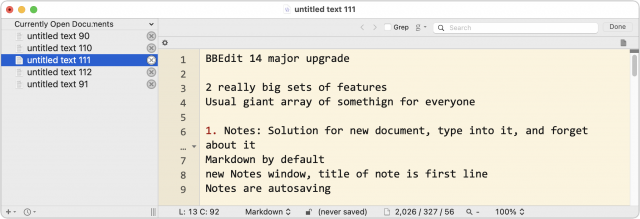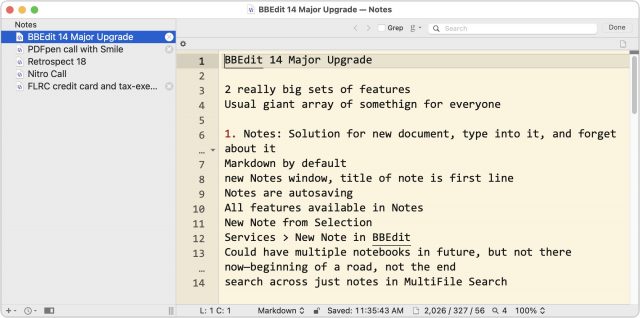BBEdit 14 Adds Simple Notes Management
Take a look at my BBEdit 13.5.7 window below, the five “untitled text ###” documents in particular. They are hastily typed notes from press briefings and bits of text I might post to a Discourse topic. I haven’t bothered saving them because I don’t anticipate needing them permanently. I’ll write the article or post the text, after which I’ll close the associated document without saving. I often have many more untitled documents—race results I’m reformatting, CSV files I’m working on, and little things I want to remember briefly.

The reason I do this is that BBEdit is really good at preserving unsaved work. It automatically saves changes in the background, opens the documents again if you quit and relaunch, and maintains state even if the Mac crashes. (Look in BBEdit > Preferences > Application for the relevant settings to make this happen.) Of course, nothing is guaranteed, and I have lost a few untitled documents once or twice over the years in particularly egregious Mac crashes. But it’s so infrequent that I don’t even consider saving such documents because I don’t want the extra cognitive load of figuring out where to store them and then having to delete them later. I am far from alone in this habit—Josh Centers said that he currently has 27 untitled documents open in BBEdit, and that’s after he went through and closed a bunch that he no longer needed.
Needless to say, people at Bare Bones Software do this too, so with the just-released BBEdit 14, they decided to turn the habit into a feature: Notes. Now, whenever you have a document like this, you can choose File > Save as Note. BBEdit automatically names the document with the first line (edit the first line to change the name later) and saves the document behind the scenes in its Application Support folder. Although this command doesn’t have a default keyboard shortcut, I’ve already created one in BBEdit > Preferences > Menus & Shortcuts.
There are numerous other ways to create notes, including File > New > Note—and notice the With Selection and From Clipboard commands underneath. You can also select some text in a BBEdit document, Control-click it, and choose New Note (With Selection). You can click the + button in the Notes window itself, or drag documents or text into the Notes window’s sidebar. There’s even a New Note in BBEdit system-wide service available from the AppName > Services menu whenever you have text selected in almost any other app.
The Notes window acts very much like a Project window in BBEdit, so it’s easy to search through all your notes with a multi-file search—there’s even a Search > Search in Notes.bbnotebookd command that opens a multi-file search window targeting the contents of the Notes window.
If you want to promote a note to a real document, File > Save A Copy works, or you can use File > Export Notes to export them all to normal documents. (By default, all notes use Markdown format.) To get rid of a note when you no longer need it, Control-click it in the Notes window and choose Remove.
Bare Bones does not intend BBEdit’s Notes feature to compete with existing note-taking apps, nor does the company plan to turn it into a standalone app. It’s just a recognition of how BBEdit users already use the app and an attempt to enhance that existing usage pattern. I haven’t had much time with the feature yet, but I anticipate using it to protect and manage my untitled documents.
BBEdit 14 has another major new feature, but unlike Notes, it’s not one that I particularly appreciate personally. Developers make up a large percentage of BBEdit’s user base, and for them, Bare Bones significantly enhanced text completion, code navigation, syntax coloring, language-sensitive document reformatting, error highlighting and warning, and more. These features come courtesy of BBEdit 14’s support for Microsoft’s Language Server Protocol. It’s a technically clever way of doing things since BBEdit itself doesn’t have to be hard-coded to know anything about the supported languages; the user can just download and install the appropriate “server” for the desired language to endow BBEdit with all the available language-specific features. Installation of the servers is left up to the user.
Other changes include:
- The new Edit > Repeat Last Command (tied to Command-Y) lets you repeat commands quickly.
- The Clipboard window has returned. Access it from Edit > Show Clipboard, and click the arrows in the upper-left corner to cycle through past clipboards.

- BBEdit sports a new icon for macOS 11 Big Sur, but if you want to go retro, you can choose older versions (even TextWrangler) from BBEdit > Preferences > Appearance.
- For data scientists who work in virtual environments using the Anaconda system, BBEdit 14 includes support for detecting and switching between Anaconda environments.
BBEdit 14 requires macOS 10.14.2 Mojave or later and is fully compatible with Big Sur. It’s available directly from Bare Bones for $49.99, and upgrade pricing is available for owners of BBEdit 13 ($29.99) and BBEdit 12 ($39.99). Those who purchased in 2021 are eligible for a free upgrade. BBEdit is also available through the Mac App Store on a subscription basis for $3.99 per month or $39.99 per year.

This is one program that I always update with any new version; not because I may want or need any of the new stuff, but just because it has always been so good, and they deserve continued support. BBEdit is my go-to program every single day for everything from making or updating web pages to making quick multiple changes in a file to … well, you get the idea. If any of the folks at BBEdit are reading this, Thank you for making my life easier every day!
Hey Folks,
BBEdit is extraordinarily useful in and of itself, but it is also scriptable – so what you can do with it is limited mostly by your imagination.
I’ve used it since 1992, and it’s run 24/7 on my systems since 1995.
Just upgraded my license for v14.
-Chris
Wahoo, the decline of Western Civilization has reversed.
This is huge for those working in oddball languages. BBEdit’s built-in language support dates to a primitive millennium, and won’t let you define (in my case) JSON5 as just like JSON except for not ruthlessly forbidding comments.
I wrote my thoughts about BBEdit 14.
Why is there still no typewriter mode?
Check the date:
BBEdit is my one exception to my “Age of Update Automatically Is Over” Rule (check out their Release Notes for why), so I was delighted to welcome the Clipboard Window back (I was one of many to request its return, long years ago). Language Server Support was less thrilling for my needs: Bazel Starlark (né Skylark, presumably an allusion to the seminal space opera starship The Skylark of Space) is still working on an LSP module, and:
Otherwise the upgrade was painless over a day’s work; even my SFTP browser to a Docker container reopened seamlessly.
As a long time user of BBEdit, I excitedly went to the Bare Bones website to read about the LSP support, but was disappointed to read that contrary to Adam’s article:
As Flash mentioned, BBEdit’s syntax highlighting/language support has been around for a awhile, and is more than a little difficult to deal with. I’ve played with the XML based Codeless Language Modules, which are quite limited in functionality, and looked at the more robust language module support, but it requires writing text parsing in C, which feels as dated as it sounds.
It’s one area where many of the newer text editors leave BBEdit behind, and many of which support the same or similar highlighting definitions. Yet I still use BBEdit more often than any other, and like Adam describes always have more “untitled documents” than I can keep track of.
Drat, sorry about that error! Perhaps @siegel will add LSP syntax coloring in a future update.